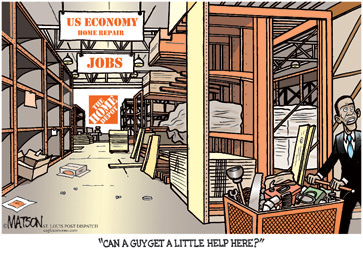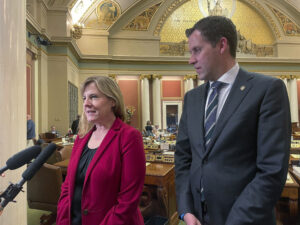Economic Policy That Might Actually Work? Who Knew?
After eight years of trickle-down tax cuts that pushed the prosperous up and left most everyday Americans sliding further down, the stimulus bill now moving swiftly through Congress is more than a reversal of political course. Let's hope it's not too late.
Now for an economic strategy that really trickles down.
Down to laid-off workers who lost their health insurance with their jobs. Down to the working poor and the newly poor, who need food stamps for their families to survive. Down to the teachers who will remain in their classrooms because states won’t have to severely reduce their aid to cities and counties. Down to construction workers, and perhaps even down to those just laid off at Caterpillar who might be called back from the unemployment line. They can get to work making the heavy equipment the construction crews will need to repair roads and bridges and sewer lines.
What a relief.
After eight years of trickle-down tax cuts that pushed the prosperous up and left most everyday Americans sliding further down, the stimulus bill now moving swiftly through Congress is more than a reversal of political course. It is a repudiation of the decades-long experiment that had at its core the notion that the only way to boost the economy was indirectly — and almost exclusively — by giving more breaks to the affluent so that the largesse eventually would flow down to the rest of us.
Almost invariably the politicians who espoused this philosophy would look at the unemployed — and decide not to boost unemployment benefits. They would look at those without health insurance — and decide not to spend money on health care delivered through state programs that could bring help quickly because those programs were already in place. They saw deteriorating railways, sewer lines, roads and bridges and for the most part chose not to fix them. That would require what they said they absolutely, positively did not want: direct government spending.
Now we are in economic quicksand and, truth be told, no one knows exactly what combination of steps will pull us out. “Policymakers in this country have no experience with fiscal stimulus on the scale currently being contemplated,” Congressional Budget Office chief Douglas Elmendorf told the House Budget Committee this week.
Still, a glimpse of what might help the most was provided by the CBO analysis of the economic boost it estimates will come from the various provisions of the $825 billion stimulus legislation written in the House. Those that produce the most bang for the buck — about $2.50 in added economic growth for every dollar spent — are the precise opposite of what we’ve been doing until now. They are the very sorts of initiatives congressional Republicans still largely oppose.
The direct purchase of goods and services by the federal government produces as much as $2.50 in growth over several quarters, the CBO says. A dollar transferred to state and local governments for infrastructure spending also is estimated to produce $2.50 in growth. Getting money directly to people through programs such as expanded unemployment benefits and food assistance is estimated to produce $2.20 in growth. And general aid to states to alleviate the problems in balancing their budgets in the face of rapidly deteriorating revenues and rapidly increasing demand for basic public services would produce $1.90.
What element is the least effective? Giving businesses a way to cut their taxes by charging losses that are incurred now against profits made in prior years only produces about 40 cents worth of growth for every dollar spent, the CBO says. It also happens to be the part of the legislation House Republicans are most happy with.
It is entirely possible that nothing President Barack Obama and Congress do in the short term will send people running back to the mall or booking a vacation. Everyone is spooked about losing a job, about losses they’ve suffered in their retirement accounts, about the way the house that was supposed to be the golden goose — producing a seemingly unlimited amount of equity to be borrowed against — has been tarnished.
What seems reasonably certain is that without massive aid to states there will be more layoffs — of teachers, of cops and firefighters, of people who repair roads, of building inspectors and others whose jobs are necessary to provide basic public services. Without getting more money quickly into the pockets of the unemployed, there will be more foreclosures and more consumers who simply have no money with which to consume.
We do not know if this giant stimulus plan will work — if it is big enough and bold enough. But at least it marks an overdue abandonment of the approach we know has failed.
Marie Cocco’s e-mail address is mariecocco(at)washpost.com.
© 2009, Washington Post Writers Group
Your support matters…Independent journalism is under threat and overshadowed by heavily funded mainstream media.
You can help level the playing field. Become a member.
Your tax-deductible contribution keeps us digging beneath the headlines to give you thought-provoking, investigative reporting and analysis that unearths what's really happening- without compromise.
Give today to support our courageous, independent journalists.






You need to be a supporter to comment.
There are currently no responses to this article.
Be the first to respond.